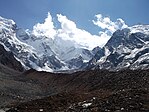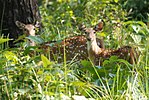This article needs additional citations for verification. (July 2014) |
Far-Western Development Region
सुदुर पश्चिमाञ्चल विकास क्षेत्र | |
|---|---|
|
Clockwise from top Saipal, Api Himal, Ghodaghodi Lake, Khaptad Lake, Swamp deer at Shuklaphanta National Park, Badimalika Temple, Dodhara Chandani Bridge, Tripurasundari, Baitadi, Ugratara Temple | |
 | |
| Country | |
| Headquarters | Dipayal Silgadhi, Doti District, Seti Zone |
| Largest city | Dhangadhi |
| Area | |
• Total | 19,539 km2 (7,544 sq mi) |
| Population (2011 Census) | |
• Total | 2,552,517 |
| • Density | 131/km2 (340/sq mi) |
| pop. note | |
| Time zone | UTC+5:45 (NPT) |
| Official language | Nepali |
| Other Official language(s) | 1. Doteli
2. Tharu (Rana) |
| HDI (2021) | 0.583 (medium) |
| Literacy | |
| Sex ratio | 91.25 ♂ /100 ♀ (2011) |
The Far-Western Development Region (Nepali: सुदुर पश्चिमाञ्चल विकास क्षेत्र, romanized: Sudura Paścimāñcala Vikāsa Kṣētra, lit. 'Far Western Development Region') was one of Nepal's five development regions. It was located at the western end of the country and had its headquarters in Dipayal.
The Far-Western Region covered 19,999.28 km2 (7,721.77 sq mi) square kilometers. It had nine districts with the regional headquarters at Dipayal, Doti district. The Far-Western Region was remote and developmentally challenged. Some 44% of people in the Far West Hills and 49% in the Himalayan districts lived below the poverty line. The region had limited basic services. The difficult topography complicated development. The region had complex socio-economic structures along with widespread gender- and caste-based discrimination. Traditional systems associated with religion, culture and customs had limited overall development.[1]
It comprised two zones:
The region was sometimes called the Doti region, which some believe originated from 'Dovati' meaning land between two rivers. Others believed it originated from the Hindu god Dev and Aatavi, meaning the place of re-creation. History went back to the 13th century when Niranjan Malldeo founded the Doti Kingdom following the fall of the Katyuri Kings. Dotiyali and Khas language were spoken there. Deuda, Jhoda, Chhpeli, Chhaliya, Bhada etc. were traditional regional dances and Gaura/Gamara is the biggest festival.
- ^ "An Overview of the Far Western Region of Nepal | Nepal Information Platform". Un.org.np. 2011-05-20. Archived from the original on 2014-07-16. Retrieved 2015-06-04.








